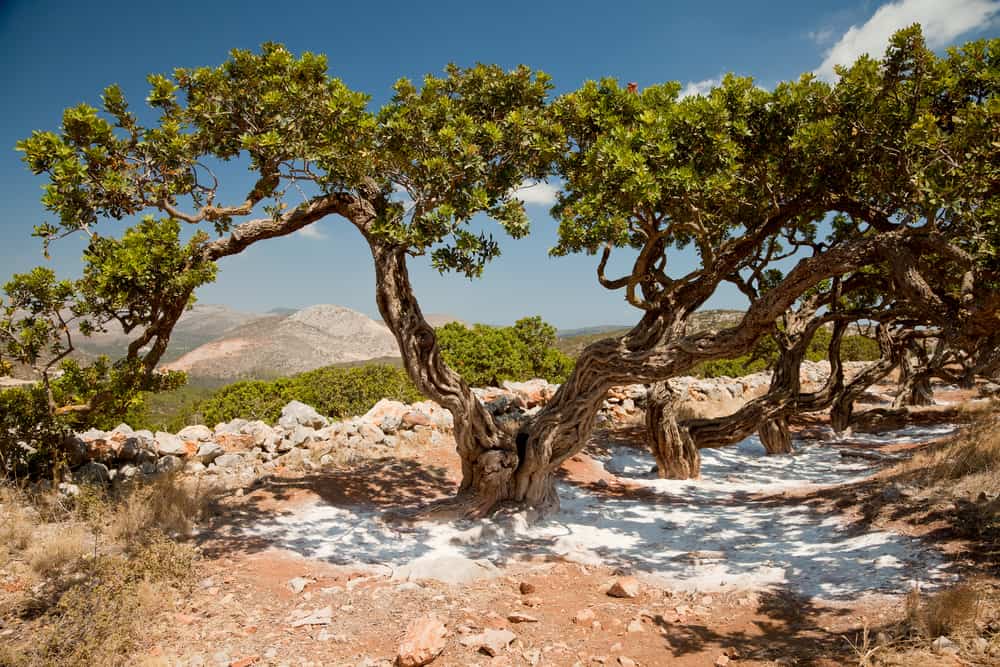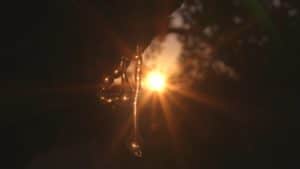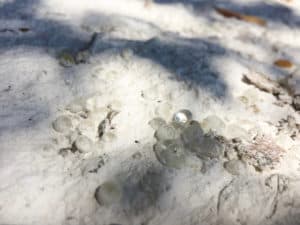Share this post
The intangible cultural heritage of Chios mastiha (mastic) gum production
Oftentimes, we take our nutritional supplements without so much as a thought to how they happen to come to the powder that fills the capsule. Others of us, who also probably are mesmerized by television shows like “How It’s Made,” the Discovery channel documentary that details the production of ordinary things like umbrellas, think about this with regards to everything. Either way, the traditional process of Chios mastiha (mastic) production is so unique it will compel those even mildly interested to learn more.
Words are hardly able to describe the beauty of the mastic resin as it drips from the incisions, known as “kentos”, from the Chios mastiha (Pistacia lentiscus var. Chia) tree, particularly when rays of sun catch them at twilight or dawn. Technically considered an evergreen shrub, these small trees and the white powder found under them cover the hills of southern Chios, the fifth largest of the Greek islands, and can easily be seen by the observant eye when landing at the small airport right outside of Chios, which also is the name of the largest city on the island.
Also evident to the trained eye when arriving from above are the “Mastihahoria” villages. Initially established in the 14th century C.E., these villages are homes to the many residents of the island in which the Chios mastiha was, and still is, processed by hand. Although once controlled by the many overlords who dictated even the coming and going of the residents from these villages, those who play a role in the Chios mastiha production are now fairly treated and compensated by the Chios Mastiha Grower’s Association. The layout of these 24 villages also sheds light on the history of Chios mastiha – their center is bordered by a wall that was used to control the entry and exit of the villagers, and even housed watchtowers to protect from invasion and theft of the mastic. Chios tears, what the mastic resin is often called, is an appropriate name not only because of the appearance, but also the bloodshed at times in Chios’s history of mastic production.
Chios tears, what the mastic resin is often called, is an appropriate name not only because of the appearance, but also the bloodshed at times in Chios’s history of mastic production.
Because of the unfair treatment of the many individuals involved in the production of Chios mastiha and its many products (which range from oral-care gum to chocolates and candies), the Chios Mastiha Grower’s Association was established, in part, to protect the Mastihahoria residents and the many others who play a part in the process. Established in 1938, this organization also serves to manage the Chios mastiha trade, research, and other aspects of commerce, such that those involved in the farming and production can focus on these tasks. The agricultural tradition and process of producing Chios mastiha also have been recognized in more recent times as a Protected Designation of Origin product by the European Union, and by UNESCO as an Intangible Cultural Heritage of Humanity.
There are many stages of the mastic production, each integral to the final product that is produced. Much like one who tends a bonsai tree, those who farm the Chios mastiha shrubs knowledgably work with the plants to ensure both their vitality and the optimal production of mastic. The island of Chios produces roughly 150,000 kilos of mastic resin yearly, although each shrub only produces approximately 120 to 200 grams. Thus, there are many caretakers and loving hands that play a role in the maintenance of the 1,500,000 plus Chios mastiha shrubs found on the island.
The stages of mastic production
In the winter, the only time when Chios typically receives rainfall in excess of 4 inches a month, the Chios mastiha shrubs are considered to be at rest. However, much activity occurs around them. In December, the process of topdressing of the ground below the mastic shrub occurs, in part by the natural leaves that are shed to the ground. In mid-January and through February, the branches of the shrubs are pruned to a specific shape, in part to ensure there are open channels for airflow and light to help dry the mastic resin later in the year when it flows.
The island of Chios produces roughly 150,000 kilos of mastic resin yearly, although each shrub only produces approximately 120 to 200 grams.
In March and April, the ground below the Chios mastiha shrubs is dug up to be renewed, along with the removal of weeds. In early summer, the area under the shrub is then swept and cleaned, forming a circular region known as the “table”. The table is then covered by calcium carbonate, a white powder, which is safe for human consumption and often used as a supplemental source of calcium or an antacid. However, its role here is to assist in the mastic collection and cleaning. When the resinous tears of mastic fall to the ground, they naturally become coated by the calcium carbonate, and can be easily seen and collected. The white table is also why the Chios mastiha shrubs can be clearly distinguished from far above.
Next, the process known as kentos, the carving of small grooves or wounds from which the mastic resin flows, is performed. Using special iron tool known as kentitiri, once weekly, these wounds are made in the trees beginning in late July through early September, depending on seasonal conditions. These wounds are made on the trunk and lower branches of the Chios mastiha shrub and must be made with care such that the plant is not damaged. Their amount depends on the size and age of the tree, while their location should also consider what is best for optimal production and easy collection. In the larger, older trees, there may even be 100 of these short, roughly 2 to 3-inch grooves, that are made, twice a week, by hand to the tree. Of all the stages in production, this process has the greatest potential to cause damage, and must be very carefully done by those who know how to care for the tree.
From the wounds drip the mastic, the Chios tears. “I am a tireless, always tearful tree” – so goes the song about mastic, known as Skiniatikos. The tears flow as long as the wounds are being made, and drip to the ground below, where the sunlight streaming in and summer island breeze helps to dry them.
“I am a tireless, always tearful tree” – so goes the song about mastic, known as Skiniatikos.
After solidifying, the Chios mastiha tears are collected. First, they are collected from the ground using a special tool, known as timitiri, that resembles a small, triangular-headed spoon. Then, with a special brush having tines like a rake, the resin that has dried on the tree is scraped off to the ground below, where it is then collected by hand or with a small broom. By collecting the tears in stages such as this, they are easier to clean, as those collected from the ground in the second stage will have the tree scrapings that must be cleaned from them, a process also done by hand.
At this point, and even during the collection of the tears, the cleaning process begins. Using tools almost the same as those their predecessors used hundreds of years prior, the villagers sieve the mastic, removing much of the calcium carbonate that was inherently collected with it. Using additional processes including salt-water baths, the Chios mastiha tears are separated from the additional contaminants such as leaves and twigs by hand. The villagers, usually women, do this and the other tasks involved in the mastic cleaning largely in groups. Much like quilting or other processes that involve substantial hand labor, this activity can be very dull, thus, it is a time for community and sharing of homes, stories, and food (and possibly even Chios mastiha liquor) while the tears are being cleaned.
Finally, the mastic producers deliver the final product to the Chios Mastiha Grower’s Association. Here, they are not only guaranteed a fair price, they are also ensured that all of their product will be purchased. The further management of the cleaning, processing, trade, and marketing of the Chios mastiha and its products then can be managed at a larger scale by those employed by the association.
Clearly, each of these stages of Chios mastiha production are a deeply held tradition – precious to the island of Chios, and also the larger country of Greece, hence their protection. This deeply held tradition, and the many products made using Chios mastiha, have even captured media interest in 2019, making headlines on news outlets including The New York Times (“Can This Ancient Greek Medicine Cure Humanity“), CNN (“The Mysterious Healing Plant That Only Grows On Greece’s Chios Island“), and most recently, National Geographic (“This Healing Plant Grows On Only One Greek Island“). With more than 10,000 kilograms being exported annually to countries including Saudi Arabia, Mauritania, Turkey, France, and the U.S., and with many other countries (in total 50) importing smaller, yet substantial, portions yearly, it is evident that Chios mastiha will continue to have global importance for many years to come.
The information used to write this article was obtained via personal communication with the individuals at the Chios Mastiha Grower’s Association, the informational video “Precious Chios Mastiha” produced by this organization, the Chios Mastic Museum, and personal travel to the island of Chios, Greece.
The information provided is for educational purposes only. Consult your physician or healthcare provider if you have specific questions before instituting any changes in your daily lifestyle including changes in diet, exercise, and supplement use.
Share this post
Dr. Carrie Decker
Related posts
From Kitty Litter to Mind Control
The science behind “Crazy Cat Ladies,” and why kitties are taking over YouTube Are you a cat or dog person? This question is more than just a conversational icebreaker, as the answer may determine in part whether or not you’re more likely to have mental illness, get in a car accident, hoard things, and/or…
Clinical Approaches to Herxheimer Reactions
Lyme disease is one of the fastest growing insect-borne infectious diseases in the United States. [1] The majority of infections occur following a bite from a deer tick carrying Borrelia burgdorferi, or one of its subspecies. Acute Lyme disease is often treated relatively easily when caught early, but newer research suggests that Lyme disease…
Seaweed for Immunity
Complex seaweed-derived compounds known as fucoidans support immune function and longevity Picture a frozen earth 635 million years ago, the planet at last beginning to thaw from an extraordinary ice age that blanketed land and sea. As the permafrost softens and melts, new life emerges from the ocean depths: sea plants.[1] The earth’s first…
A Better Diet for Better Sperm Health
Simple ways to improve male fertility If you’re planning to start a family, here’s how to improve your chances of success. About 2/3 of couples succeed in getting pregnant within six months of starting unprotected sex. However, as many as 1 in 6 couples do not become pregnant within a year. Although the focus…
Cardiometabolic Disease: How Much Does Diet Matter?
A recent report by The Journal of the American Medical Association (JAMA) looks at the relationship between dietary factors and heart disease, stroke, and diabetes-related deaths in the United States Heart disease, stroke, and type 2 diabetes collectively caused 702,308 deaths in the United States in 2012.[1] Each of these conditions has been demonstrated…
Molecular Hydrogen as a Neuroprotectant
A potential new treatment for neurodegenerative diseases Neurodegenerative diseases, such as amyotrophic lateral sclerosis (ALS), Parkinson’s disease (PD), Alzheimer’s disease (AD), and Huntington’s disease (HD), among others, are often associated with oxidative stress and neuroinflammation.[1],[2] In each of these diseases, there are similarities in the role of genetics, neurotransmitters, accumulation of toxic proteins, membrane…
Categories
- Botanicals (56)
- GI Health (53)
- Healthy Aging (121)
- Immune Support (39)
- In The News (39)
- Kids Health (21)
- Stress and Relaxation (50)
- Uncategorized (1)
- Video (9)
- Vitamins & Minerals (51)






